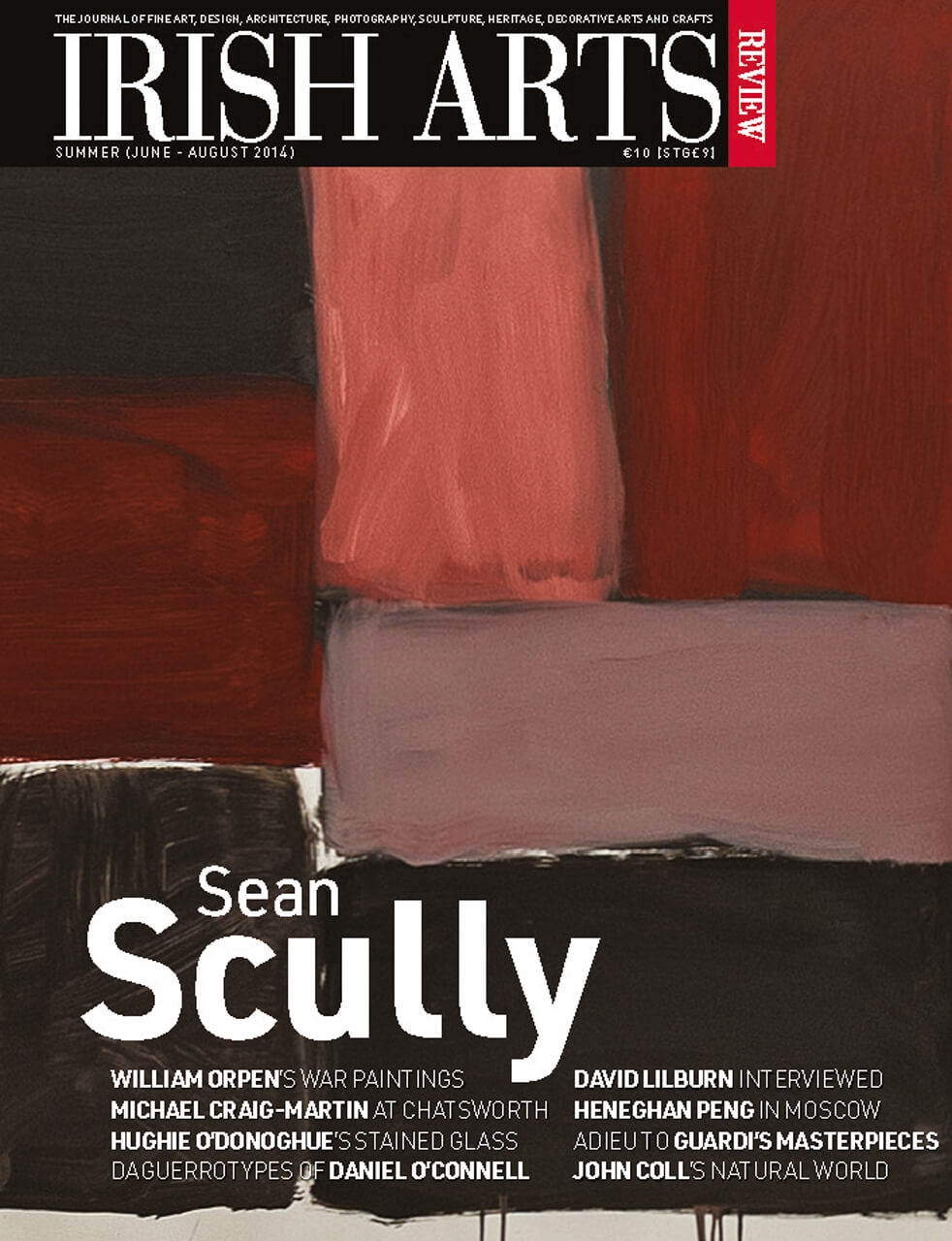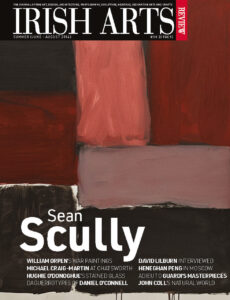

Misfortune compelled Grace Gifford to assume a political role, yet her true passion for the theatre emerges in her witty drawings, writes Hilary Pyle
Orpen’s oil of his pupil, Grace Gifford (1888-1955),1 as Young Ireland, portrays the ‘smiling woman’ he deemed fashionable,2 the quintessence of youthful confidence (Fig 1). His young nationalist sitter came from a complex background,3 as did many of her contemporaries anticipating a free Ireland. Her parents, Catholic and Protestant – both Unionist in outlook – took an active interest in the arts, and saw half their family of twelve following their father into the law, the other half turning to creative work of some kind. Frederick Gifford, a wealthy solicitor and land agent, loved and performed drama, especially the latest Gilbert and Sullivan operas. One great uncle had abandoned a prestigious painting career to become Director of the National Gallery in London, while another had famously attempted to found a socialist colony on his estate during the 1830s. J B Yeats, Griffith and other leading cultural figures, came to their ‘At Homes’.
The Gifford children were divided in their loyalties, and argued fiercely about religion and politics at table, the nationalist girls being most vocal: yet they supported each other, even when many of them emigrated to the United States.
Grace excelled in drawing at the Dublin Metropolitan School of Art and London’s Slade. Her gift for caricature was evident, and she planned to make her living as a cartoonist, at the same time as getting more involved with the nationalist movement. She supported Countess Markievicz in humanitarian activities and protests, she joined the Irishwomen’s Franchise League and Sinn Féin, but she did not join the Irish Citizen Army as her older sister Nellie did, and literature and theatre were her passions rather than politics.
Her earliest drawing to survive is The Mad Tea-Party,4 dated 1907, skilled and Victorian in style. By 1912 her inimitable pared-back manner is established in caricatures that are fanciful and eminently linear, with passages of ballooning black. She parodied the proposed tribute to the polymath neurologist, poet and scholar, George Sigerson (a resolute nationalist), for his services to Irish culture. The form the memorial should take was in serious discussion at the time.5 She favoured a classical pose on horseback (Fig 2) – as Saint George – the doctor raising his Viking eyebrows, while flourishing a sword. The dragon or serpent (associated with medicine) rises from the Celtic twirl of its tail to proffer a sympathetic cup of tea, laced with whiskey. Another cartoon demotes Mahaffy – Professor of Ancient History at Trinity College and opposed to the Gaelic Revival – to the level of dancer on a Greek vase. Lady Gregory stands on a globe, ‘sighing for New Worlds to Kiltartanese’; while George Russell, (AE) (Fig 5), who worked with Sir Horace Plunkett’s Irish Agricultural Co-operative, appears as a frustrated (with the Government Department) Russian bear. To intensify the piquancy of her image, the artist signs herself ‘Grace Giffordski’. She’s not interested in elegantly inscribed captions, but places more importance on composition, emotion and wit in her drawings.
She had studied the best of black-and-white art as it enjoyed a revival during her student years, and favoured Charles Keene of the early period above Phil May – star of the 1890s – with his swift brilliant images. He was unsubtle, she told Joseph Holloway; he could bring out the comic in everyday things, but lacked the ‘tender eye’ of the artist. Charles Keene surpassed him with his intense beauty of line, his sense of mystery, the humour and perfection of design in his concepts.6 Holloway was not so sure.
About this time Gifford was described as attractive and quirky. Joseph Holloway’s niece saw her in 1913 in Grafton Street, wearing a dress of vivid blue with pink stockings and a motor bonnet with a long pink veil. ‘You could mistake her for a third rate music hall artiste,’ she told her uncle, asking him, ‘what sort’ was Norman Morrow,7 her ‘intended’. ‘I said a thorough Bohemian like all the Morrows! And she replied, ‚Äúshe thought as much, only one of that class would suit such a colour scheme, Miss Gifford was a strange little lady, and no mistake‚Äù.’8
Gifford became friendly with Holloway, architect and art collector, when making her name in the Shanachie, Irish Citizen, and Irish Review. He bought two of her drawings for Irish Life. Sending them, she remarked that she would have chosen the George Moore and Kerrigan and Yeats cartoons in preference. Holloway – himself an inveterate sketcher of mankind around him – was frank, and replied that he felt she had missed the magic touch in those two that made most of her drawings such startling likenesses. She valued such criticism, ‘It is the first honest review I have ever had’, she said; she was thinking of giving up making caricatures because she was too rushed to think them out properly. ‘I generally do them about 11.30 on Sunday night’, she said ‘‚Ķ just in time to catch the last post! ‚Ķ besides Irish Life is always so afraid of being personal and that means boiling down your ideas till there is little or no point left!’
Holloway helped her send cartoons to the exhibition of Irish Art in London that year, at Whitechapel, and saw that she contributed to the first exhibition of the Black-and-White Artists Society of Ireland. ‘Don’t dream of letting your great gift slumber, he urged. ‘Keep on making your wonderful distorted mirrors of those you see around.’ She started on a series of small portrait heads of actors, poets, artists and musicians (including Harry Clarke and Jimmy O’Dea),9 probably with the idea of a book with a theme; and, when she eventually came to publishing her first collection of caricatures of notable Irish personalities,10 she remembered his counsel. She turned to Hamlet for title, where he advises the Players, ‘to hold, as ‘twere, the mirror up to nature’.
In 1914, Edward Martyn, Thomas MacDonagh and Joseph Plunkett set up the Hardwicke Street Theatre to produce Continental masterpieces and drama in the Irish language, and she was there to paint scenery and make costumes, while her sister Nellie acted small parts. She forgot about Morrow, pining for her in London,11 and soon became engaged to the poet, Joseph Plunkett, who was involved in all she cared about. The wedding they planned for Easter 1916 had to take place in his death cell; and immediately public opinion forced her to assume an iconic role, that of sacrificial widow – acting which must have come naturally with her experience in theatre, though the sorrow must have been unbearable. Mrs Joseph Plunkett was elected to the Sinn Féin executive in 1917, and she later spent time in Kilmainham Gaol with the dissidents in 1923.
A political profile was never her aim, however. She painted images on the walls of her cell. She could see an opening for her art in anything (even soap advertisements) – satirical if possible; though here a Madonna and Child, probably in memory of her deeply spiritual husband, reflected the actuality of her political commitment.12 Gifford threw herself into the nationalist cause, providing quickly run-off cartoons for nationalist pamphlets and Sinn Féin propaganda. She still continued her artful caricatures, but as ‘Grace Plunkett’ – and with added punch and elegance. Edward Carson titivates in private before a looking-glass, Tim Healy pinions ‘the Timid Witness’ on his breakfast fork, De Valera walks a circus tightrope carrying the Irish Republic flag over his shoulder, and Robert Barton, Minister for Agriculture in the Sinn Féin Parliament, busies himself in manicuring the trotters of a robust pig (Fig 4). The artist borrowed the name of her socialist uncle Vandeleur for her signature in a few cartoons only (Figs 3&4). Her first album had gathered together a mixture of politicians, writers and artists. She was spending a lot of time in the theatre, which was so alive in Dublin at the time. She had always sketched at the Abbey, and had already caricatured Yeats with Lennox Robinson and Lady Gregory, in The Rising of the Moon. Now she caricatured them again, discussing the Dublin Drama League,13 in her mischievous Yeats Among the Spooks (Fig 3) – Robinson and Yeats were a gift for cartoonists. In 1929 she published her theatrical cartoons as Twelve Nights at the Abbey Theatre: and it was so popular that it was succeeded the following year by a subscription volume, Doctors Recommend it: An Abbey Tonic in Twelve Doses, also printed by Three Candles Press. T C Murray’s foreword captures her perfectly – as Puck in the Athenian wood. ‘The drawings assembled here’, he wrote, ‘‚Ķ seem to become as essential an element in the life of the theatre as the art of the players whose genius inspired them.’ Some of these dramatic conceptions from plays acted in the Abbey over the years appear as frozen tableaux, which adds to the witty presentation, others are as alive as if just happening; and all the scenes she chooses are from timeless masterpieces by Synge, Yeats, Robinson, Gregory, and O’Casey, the actors immortalized in strongly-knit provocative compositions. In such pages, Grace Gifford Plunkett preserved images of an historic era in the development of Irish culture, keeping alive, in her distorted mirror, the creative and aspirational Ireland she saw around her.
She would never remarry, and there were difficulties with the Plunketts over her husband’s legacy. However, with the advent of the Fianna Fáil government in 1932, she was granted a civil list pension. During the 1930s she published cartoons in Dublin Opinion and the Irish Tatler and Sketch, but in later years she suffered from poor health and loneliness, and she died in Dublin in December 1955.
My thanks to Mary Broderick, in Prints and Drawings, and the staff of Manuscripts and the Main Library of the National Library of Ireland, for all their ready assistance.
Hilary Pyle is the author of Cesca’s Diary 1913-1916: Where Art and Nationalism Meet (2005).



